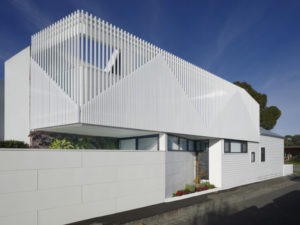Project Description
Casa Meztitla is an intervention into a natural scenario. It showcases the luxurious value of leisure, the tropical weather, the intense sunlight, the smells of nature, the over 500-year-old landscaped terraces and the ever-present rock mountain: El Tepozteco. It is a context in itself. The house, built out of rough stone, crouches low under the trees, aligned with the stone slopes covered in vegetation. It represents thecreation of pure space within the natural space. It enables introverted living, yet is continually open to its surroundings. Only two elements reveal its existence to the outside world: the colourful bougainvillea flowers showing randomly through the dense tree foliage, which mark the perimeter of the plot, and the massive and monolithic white box that emerges through the treetops.
The layout of the house is divided into four areas: a social area with the living and dining room, an open kitchen, and a ‘portico’ looking out at the grass patio (the only artificial nature in the project) which is the centre of the house, and the floor slab that covers the drinking water reservoir with a capacity of 280m3 (61,591 gallons); a service area housing a grill, a toilet and a shower room, laundry and storage area; the bedroom area (two main rooms and two guest rooms) all accessed through outdoor patios, with the two main rooms on the far sides each having a private patio each; the studio as the fourth area on the second floor, which is accessed from the roof terrace and is open on both sides to a pair of outdoor patios.
The theme of the house is not about its usage, but about the never-ending relationship between indoors and outdoors. One cannot go from one area to another without walking through outdoor spaces. Every area (except for services) is open to the exterior. The house works as a series of rooms connected by various types of outdoor area. The mild, subtropical weather was used as an excuse for building a house that is not closed within itself, but constantly opens out towards the natural environment, designed to bond the house, the life within it and nature together in a symbiotic relationship.The construction materials are basic, locally provided and crafted: concrete for the foundations, basement, and main structural elements; volcanic rock and cement block for the walls; a mix of white cement and lime for plastering the white walls. Interior walls and ceilings are finished with white cement and lime plaster, the floors with exposed polished concrete. Carpentry consists of pine wood and plywood varnished with oil and wax. The pivoting doors are made of steel with tempered glass. The selection of material for the furniture is based on natural woods and light fabrics, steel and polypropylene. There is a significant emphasis on using traditional tropical Mexican furniture, such as hammocks, rocking chairs and wooden chairs.
There are economic and contextual reasons for this simple and logical selection of materials throughout the project, meeting the client’s requirement for a low-maintenance house in a subtropical rainforest. The materials will age naturally and blend with the context.The reason for pivoting glass doors is simple: the plot is set within an extraordinary natural scenario and the weather is mild, inviting the creation of a house that would be open and in touch with nature, but the clients were not comfortable with the idea of being too exposed. Closing the opening with pivoting glass doors was therefore a good solution, enabling the degree of exposure to be adjusted individually, while maintaining a constant visual relationship with the outdoors. The pivoting elements are also an expressive architectural feature.























































